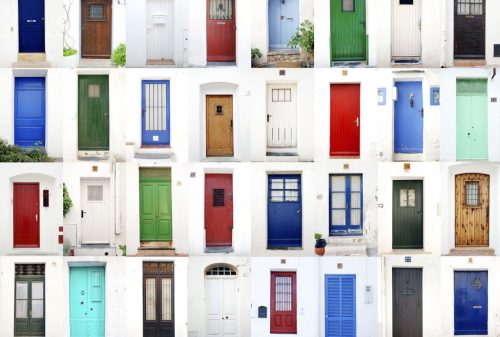The Surprising Things Your Front Door Reveals About Your Soul
The Surprising Things Your Front Door Reveals About Your Soul

Thinking about freshening up your front door? You probably know that it’s crucial to boosting your home’s value. But before you reach for the paint, know that your choice of color might tell perfect strangers quite a lot about who you are.
That’s according to environmental psychologist Sally Augustin of Design With Science. She took us on a tour of the color wheel to get her insights on what each shade might indicate about a homeowner’s characteristics. So in addition to deciding which shades work best with your exterior color palette, think about the statement you want your front door to make.
Violet
Dreaming of painting your front door purple? Prepare to feel like royalty: Shades of violet are “linked to sophistication,” Augustin says, and visitors will expect the same attention to luxury in your interiors.
But be careful when picking a shade—purple can easily turn from luxurious to garish.
Orange
This bright, affordable shade can mean different things depending on the quality of your home. (No, not all colors cost the same—and orange tends to be one of the cheapest.)
For most homes, an orange door can send the message that “I’m cheap or weird,” Augustin says. But paired with tasteful home accents inside, an orange door might just be the perfect touch for your one-of-a-kind style.
If you’re lucky enough to own a high-end home, “you transcend that message,” Augustin says, citing the luxury brand Hèrmes’ trademark orange.
“When it’s clearly expensive, you can do whatever you want.”
White
What does the most common of all front door colors say about you? You might be a neat freak, or just really into modern Scandinavian design. The least neutral of the neutrals, white indicates sterility, cleanliness, and simplicity. On the flip side, it can also say “this homeowner is way too obsessed with cleaning her baseboards,” and might make visitors nervous about making a mess.
Yellow
Looking to stand out on your block? This bold shade certainly makes an impression: Yellow is linked to optimism and extraversion. Guests will expect sunny rooms and cheerful decor inside. Don’t splash it everywhere, though—it looks best as a spot of color against a darker home. If you cover the whole house, it can indicate irrationality and anxiety.
Blue
Looking for visitors? Try painting your front door a bright blue, which is linked to calmness and trust.
“If you were knocking on a blue door and you have time to ponder a second, you might come to the conclusion that the homeowners were more likely to be trustworthy,” Augustin says.
Green
Green is one of the best-selling door colors (in Britain, at least). Traditionally, the color indicates prosperity and wealth, but its natural appeal means you’re also serene and peaceful. Don’t be afraid to pick a vivid green, though: Too neutral and you might seem bland.
Black
What’s more stately than a solid black door? If you’re looking for a color that connotes seriousness, this one’s for you. This traditional color often seems formal, but you can add a playful tone with a modern black door against a colorful exterior. Covered with a shiny veneer, it’s definitely glamorous—and might make your home appear safer and well-protected.
Wood
Don’t want to paint? Unpainted wood “conveys a more relaxed atmosphere,” Augustin says, with a rustic appeal that’s both cozy and welcoming. But you’ll want to carefully consider whether the material makes sense in your neighborhood.
Red
The Chinese design philosophy of feng shui considers red doors lucky if they’re facing south or southwest. Even if your home faces another direction, Augustin says this conventional color is “often linked with things like action,” making dwellers seem like “real go-getters.” Want to seem vibrant and exciting without going too wild? This might be a good bet.
Brown
Some might see you as practical, but you risk going past practical into humorless with this plain, common door color. Still determined? Try choosing a lighter shade, which is a warmer, softer alternative to black or wood; a darker shade will seem somber.
By:
Article found: https://goo.gl/2YsrzJ



